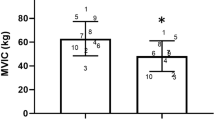Abstract
A number of studies have investigated the use of variability measures in the detection of submaximal or insincere efforts in strength testing. The underlying assumption of these approaches is that submaximal efforts will be more variable than maximal efforts. Previous studies have investigated the variability of torque production in isometric or isokinetic tasks with mixed results. The present study investigated the variability of torque production and velocity in isometric and isotonic leg extension tasks, respectively. Fifteen asymptomatic subjects participated in a within-subject counterbalanced design in which they were asked to perform maximally and submaximally in both isometric and isotonic leg extension tasks. Results indicated that both isometric and isotonic tasks showed greater variability (measured by coefficient of variation) in the submaximal effort condition. However, the sensitivity to detect submaximal efforts was much greater for the isotonic velocity variability condition. It was concluded that the isotonic approach showed promise for clinical application, but that the isometric task had unacceptably poor classification rates, consistent with previous research.
Similar content being viewed by others
References
Webster BS, and Snook SH. The cost of 1989 worker's compensation low back pain claims.Spine 1984; 19: 1011–1016.
Niemeyer LO, Matheson LN, Carlton RS.Indust Rehabil Quart 1989; 2: 5.
Agre JC, Magness JL, Hull SZ, Wright KC, Baxter TL, Patterson R, Stradel L. Strength testing with a portable dynamometer: Reliability for upper and lower extremities.Arch Phys Med Rehabil 1987; 68: 454–458.
Niehbur B, Marion R. Detecting sincerity of effort when measuring grip strength.Am J Phys Med 1987; 66: 16–24.
Hazard R, Reid S, Fenwick J, Reeves V. Isokinetic trunk and lifting strength measurements: Variability as an indicator of effort.Spine 1988; 13: 55–57.
Robinson ME, MacMillan M, O'Connor P, Fuller A, Cassisi J. Reproducibility of maximal vs. submaximal efforts in an isometric lumbar extension task.J Spinal Disord 1991; 4: 444–448.
Robinson ME, O'Connor PD, MacMillan M, Fuller A, Cassisi JE. Effect of instructions to simulate a back injury on torque reproducibility in an isometric lumbar extension task.J Occup Rehabil 1992; 2: 1–9.
Robinson ME, Geisser ME, Hanson CS, O'Connor PD. Detecting submaximal efforts in grip strength testing with the coefficient of variation.J Occup Rehabil 1993; 3: 45–50.
Robinson ME, O'Connor PD, MacMillan M, Shirley FR, Greene AF, Geisser ME, Fuller AK. Physical and psychological correlates of isometric torque variability in patients with chronic low back pain.J Occup Rehabil 1992; 2: 11–18.
Schmidt DE, Zelaznik HN, Hawkins B, Frank JS, Zuinn JT. Motor output variability: A theory for the accuracy of rapid motor acts.Psychol Rev 1979; 86: 415–451.
Sherwood DE, Schmidt RA. The relationship between force and force variability in minimal and near-maximal static and dynamic contractions.J Motor Behav. 1980; 12: 75–89.
Sherwood DE, Schmidt RA, Walter CB. The force/force-variability relationship under controlled temporal conditions.J Motor Behav 1988; 20: 106–116.
Carlton LG, Newell KM. Force variability and movement accuracy in space-time.J Exp Psychol 1988; 14: 24–36.
Newell KM, Carlton LG, Hancock PA. Kinetic analysis of response variability.Psychol Bull 1984; 1: 133–151.
Newel KM, Carlton LG. Force variability in isometric responses.J Exp Psychol: Hum Percept Perform 1988; 1: 37–44.
Author information
Authors and Affiliations
Rights and permissions
About this article
Cite this article
Robinson, M.E., O'Connor, P.D., Riley, J.L. et al. Variability of isometric and isotonic leg exercise: Utility for detection of submaximal effort. J Occup Rehab 4, 163–169 (1994). https://doi.org/10.1007/BF02109972
Issue Date:
DOI: https://doi.org/10.1007/BF02109972




